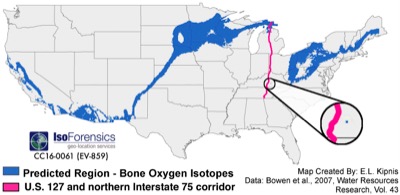Wednesday, June 14th, 2017
Bones: Victim's origin narrowed
Forensics test reveals more clues in case
By Ed Gebert

Photo by Daily Standard Staff
The bones found on West Bank January 3, 2016 underwent forensics testing, revealing possible locations where the unidentified homicide victim may have lived in the last 10 years, shown here in blue.
CELINA - Forensics test results have revealed possible locations where an unidentified homicide victim may have lived in the last 10 years.
Mercer County Sheriff Jeff Grey planned to reveal during a news conference today that parts of the victim's skeletal remains, which were found Jan. 3, 2016, south of Celina near Grand Lake, had been intentionally removed before the body was dumped. The bones were first discovered by a person walking in a wooded area near U.S. 127 and Coldwater Creek Road.
"The body was definitely dismembered," he said. "We do not have a skull. We know that the head was sawed off of the spine because we have the teeth marks of the saw. We also don't have any body parts below the elbows or below the knees, and we have some saw marks on some pieces there."
Previously released details from the investigation revealed the man was 20-35 years old and ranged in height from 5 foot 7 inches to 6 feet 1 inch, Grey said.
Investigators are missing some pieces of the torso, but Grey said they may have missed those during the search or an animal may have dragged them off.
"We believe the body was dumped based on the anthropology," he added. "They didn't dump the bones, they dumped the body. We have some small pieces of flesh that hadn't decomposed yet."
The forensics test, conducted by IsoForensics Geo-location Services, tested the oxygen in the bones, which helps narrow down the approximate area where the victim had lived in the last 10 years.
Grey showed the map provided by the company, pointing out two specific areas of interest.
"What has us intrigued right now is this area in Michigan and a little dot on the map in Kentucky," he said. "Both of those are on U.S. 127. We've cut down our search area from the whole United States to this area."
Another test is being done on a bone fragment to measure the minerals in the water. Results are due back in about a month to six weeks. Grey said, he will be very interested to see if the results from the bone oxygen map will intersect with the results from the water minerals test.
Grey said he is publicly releasing these details as the focus of the investigation has shifted from trying to identify the killer to identifying the victim.
"Typically on a homicide, you don't tell people everything because the bad guy knows," he said. "But at this point, we don't know who (the victim) is, and if we can't figure out who he is, I don't think we can solve it. We don't have a place to start."
The man is assumed not to have been from this area because Grey has no reports of local missing people who fit the profile. A company that makes composite drawings of individuals based on DNA results was unsuccessful in producing an image, he said.
No solid leads have turned up yet, Grey added, but the tests are giving authorities new places to look. He said he believes the remains were dumped at the site between January 2015 and the discovery of the bones in January 2016.
"With the weather we had, it is more likely it was only three to four months before January, back to the August-September-October range, that the body was put out there," he said.
Grey's office is seeking help from police agencies along U.S. 127 in Michigan and in Kentucky. He said he hopes that any information about the case will turn up some leads concerning the victim's identity.
